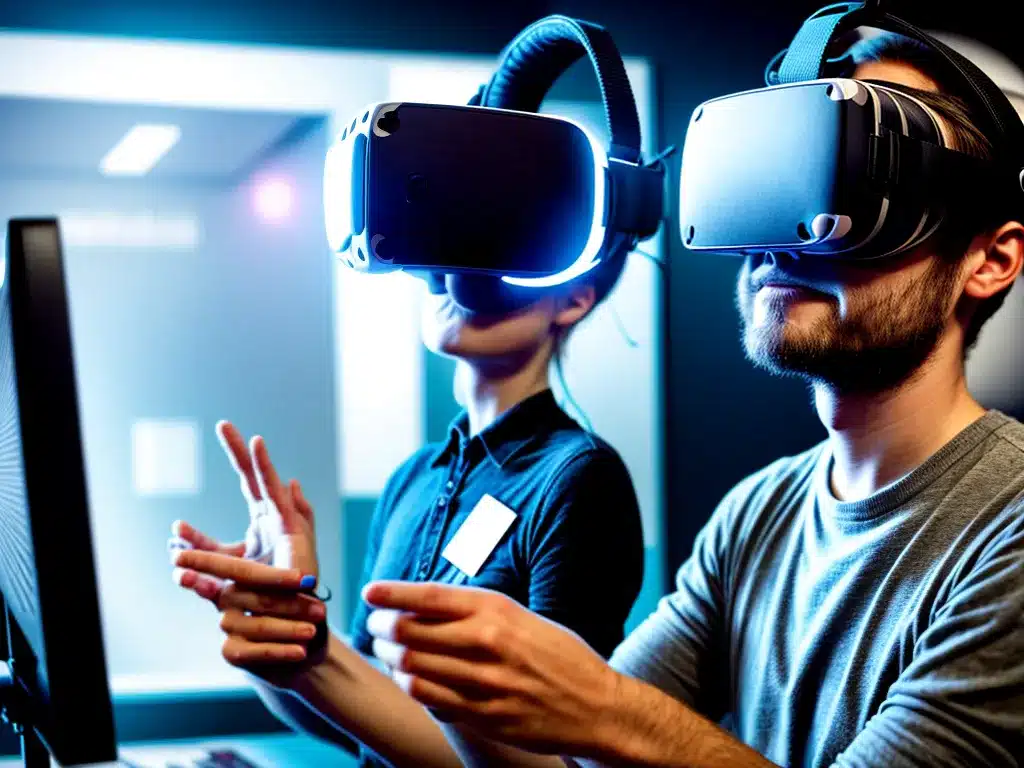
Virtual reality (VR) has long held the promise of revolutionizing how we interact with computers and information. As immersive VR technology becomes increasingly sophisticated and accessible, it is bringing us closer to realizing that vision. Here is an in-depth look at how VR may transform human-computer interaction.
Current State of Virtual Reality
Virtual reality aims to fully immerse users in a simulated, three-dimensional environment that reacts to their motions and actions. While the concept has been around for decades, some key recent advancements have helped bring VR into the mainstream:
-
More powerful and affordable hardware – Modern headsets like the Oculus Rift and HTC Vive provide high resolution displays, precise tracking, and powerful graphics at consumer-friendly prices.
-
Motion controllers – Handheld controllers with inertial measurement units precisely track hand and finger motions, allowing for natural interaction with virtual objects.
-
Room scale tracking – External sensors track head and controller movements throughout an entire room, increasing the realism of moving freely in a virtual world.
-
Better software – Improved VR software engines, toolkits, and frameworks have made it easier for developers to create immersive environments.
These improvements have expanded VR’s presence. Over 5 million VR headsets were shipped in 2017 alone, indicating rising consumer interest.
How VR May Transform Human-Computer Interaction
So how exactly can virtual reality enhance human-computer interaction? Here are some of the key ways the technology may have impact:
Natural Hand and Body Motion
One of the promises of VR is providing intuitive, natural interfaces for manipulating virtual objects and environments. Rather than simplistic handheld controllers, VR allows us to reach out and interact with virtual objects using actual hand motions, as detected by motion controllers. Full body tracking systems even let us use our entire body. This makes interaction more immersive, direct, and spatial.
Immersive Experiences
By replacing monitors with wraparound headsets and earphones, VR immerses users in computer-generated worlds, letting them feel present. This produces an unparalleled sense of scale, depth and emotion. VR expands computing from 2D screens to 3D worlds we can be inside. This will enable more experiential computing applications.
Social Connection
Though often considered solitary, VR enables shared immersive experiences with others. Multi-user social VR platforms allow people to interact together in virtual spaces. This helps form emotional bonds and relationships by adding physical embodiment, proximity, and shared context missing from traditional online interaction.
Spatial Computing
VR lets users visualize and manipulate spatial relationships in an intuitive way. We can see and touch data, move information around a room, or build 3D models. VR turns computing into a spatial, experiential medium rather than an abstract one. This may change how we approach tasks that involve spatial relations.
Complete Sensorimotor Engagement
By filling our field of view and using both hands for interaction, VR occupies our primary senses and motor functions. This creates a sense of presence and direct connection with virtual objects and environments. Total sensorimotor engagement will enable revolutionary applications and modes of interacting with computers.
Embodied Cognition
Embodied cognition theories argue that cognition depends on the interplay of the mind, body, and physical environment. VR puts this into practice by situating users within interactive virtual environments that engage their whole bodies. This embodied computing approach may thus enhance and transform our cognitive processes.
Challenges and Concerns
While exciting, VR’s potential human-computer interface revolution also raises some challenges and concerns:
-
Software library – More killer apps and AAA game titles needed to drive consumer adoption.
-
UX design – Designing effective VR interfaces requires different techniques than 2D screens. New UX paradigms are still evolving.
-
Motion sickness – Visual/vestibular mismatch in some users causes discomfort. Better hardware/software tuning needed.
-
Long-term issues – Effects of prolonged immersion in virtual worlds remain unknown.
-
Behavioral issues – Isolation from physical world may produce psychological issues.
-
Privacy – VR interacts intimately with users’ senses and movements, raising privacy issues. Data protections needed.
The Future of VR
Despite some hurdles, virtual reality possesses immense potential to transform human-computer interaction. Upcoming developments like eye tracking, tactile feedback gloves, and inside-out tracking will push VR realism and immersion further. As VR technology matures and gets infused into smartglasses and other form factors, it may drastically change how we perceive and interact with computers and information in the future. But ethical guidelines and user-centric design considerations will be crucial for crafting responsible VR experiences that enrich users’ lives.












